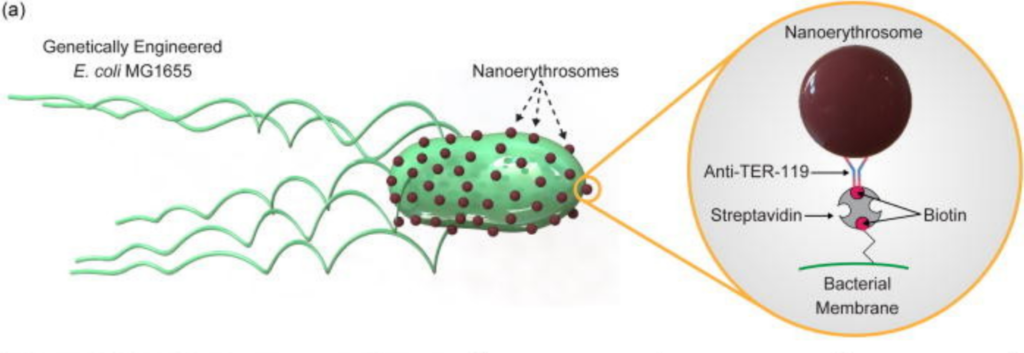.
S O U R C E : Life Extension Advocacy Foundation (LEAF)

A group of researchers has succeeded in engineering a new kind of microscopic bio-object that may one day be used for personalized diagnostics and targeted delivery of drugs. The object consists of a genetically modified E. coli bacterium and nanoerythrosomes (small vesicles made of red blood cells), and it demonstrates a substantial improvement in motility over previous designs [1].
Nanomedicine
Nanomedicine strives to create methods for targeted diagnostics, monitoring, and therapy on a cellular level. Such objects could potentially act upon chemical signals to patrol our body for any signs of disease and/or deliver therapy directly to affected cells (see our recent report on DNA origami nanorobots). One of these avenues of exploration involves objects called “biohybrid microswimmers”, in which living bacteria are used for navigation and propulsion.
Why bacteria?
Bacteria are no strangers to our body: there are at least as many bacteria in our body as our own cells [2]. Many types of bacteria are nontoxic and non-immunogenic; the human immune system does not react to them. Being living creatures, bacteria can navigate towards stimuli such as food sources, light, oxygen, or, in the case of anaerobic bacteria, a lack thereof. On their way, bacteria are able to penetrate tissues and squeeze through extremely tight passages. Moreover, scientists have found that some bacteria can be steered from outside the body by acoustic waves or a magnetic field and can be made easily detectable in the body for diagnostic and monitoring purposes [3].
Several decades ago, it was discovered that strictly anaerobic bacteria looking for oxygen-free environments and food accumulate in the vicinity of hypoxic and necrotic regions of solid tumors. This led to experiments in cancer bacteriotherapy. Along the way, scientists had realized that genetic modifications can increase the therapeutic effect of bacteria, such as by making them produce certain chemicals. Genetically recombinant bacteria have since been used for the treatment of cancer, diabetes, viral infections, and other pathologies, with numerous treatments reaching clinical trials [4].
The next logical step was to make bacteria deliver any kind of payload in external packages. For a few years, scientists have been producing promising designs by chemically attaching microparticles to flagellated bacteria such as the ubiquitous E.coli.
RBCs as cargo containers
Red blood cells (RBCs), or erythrocytes, have been tested as cargo containers. These cells are naturally adapted to delivering payloads: as they mature, their organelles disappear, and the cells basically become pouches in which hemoglobin-attached oxygen molecules are stored as they are distributed to the tissues. The idea is to replace RBCs’ cytoplasmic content with drug molecules and superparamagnetic iron oxide nanoparticles (SPIONS) that enable external navigation via magnetic fields [5].
Despite RBCs’ commendable ability to squeeze through passages smaller than themselves, they are still around 8 μm in diameter. An E.coli bacterium, on the other hand, measures only about 2 μm in length. Consequently, designs based on RBCs attached to E.coli demonstrate limited motility and penetration ability.
Making RBCs even smaller
The current study strives to overcome this limitation by using nanoerythrosomes – smaller particles produced from RBCs. First, the researchers had isolated RBCs from murine blood. RBCs were then emptied of their cytoplasm and passed through a polycarbonate membrane with 1 μm pores. As a result, numerous nanoerythrosomes were formed with an average diameter of 350 nm. These nanoerythrosomes are, essentially, hollow vesicles that can potentially be loaded with cargo. Just as RBCs are, they are non-immunogenic, since they retain membrane proteins that make RBCs recognizable to our immune system.
To create an attachment mechanism, the researchers had genetically modified E.coli to express biotin (vitamin B7) on its membrane. The same was achieved for the nanoerythrosomes by using certain antigens to induce biotin molecules. The bacteria were then treated with molecules of streptavidin, a protein that exhibits an extremely high affinity for biotin. Biotin and streptavidin form strong non-covalent bonds. As a result, the biotin present on the bacterial membrane had connected with the biotin present on the nanoerythrosomal membrane via streptavidin molecules, creating a biotin-streptavidin-biotin bond.

Genetically engineered E. coli bacterium with nanoethryosomes
Due to the smaller size of nanoerythrosomes compared to full-grown RBCs, the resulting biohybrid microswimmers demonstrated superior motility compared to previous designs.
.../...
.










































